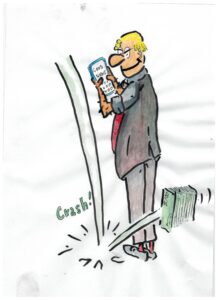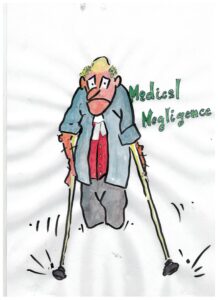Breach of duty of care – motor vehicle accidents – you decide?
- 2016-10-19
- By whiggs
- Posted in Motor Accidents, Other
You decide ?Mr Kidd gave evidence that he was driving a yellow bus, proceeding south-easterly on Talavera Road when he faced a red light at the Herring Road intersection and came to a stop. He had been a professional bus driver for six years and was well familiar with the intersection. He said the green arrow allowed two buses through on each phase. He was the first vehicle in the right-hand turn bus lane at the lights. He waited until he received a green arrow to turn right, and when that appeared he proceeded into the intersection. When he was about 15 metres into the intersection, he first noticed Mrs Aziz’s car proceeding in the opposite direction towards the intersection about 100 metres away. As he continued he became concerned that she might not stop, contrary to the red light he believed she must have been facing, and shortly before she entered the intersection, he proceeded to stop the bus when its front was about a third of the width of the lane or about a metre across the continuation of Mrs Aziz’s lane. He said she had room to drive around the bus. Mrs Aziz did not stop but collided with the front of the bus on the driver’s side. When she exited her car, she swore at and abused Mr Kidd, maintaining she had a green light.
Mrs Aziz agrees with Mr Kidd’s account of her conduct after the collision. She gave evidence that she proceeded into the intersection because she faced a green light and had right of way. She did not see the bus until she was in the intersection and could give no evidence of other vehicles. She made no attempt to drive around the bus.
Both Mr Kidd and Mrs Aziz were faced with two witnesses whose recollections differed from theirs. Esme Wilson and Loan Yen Banh were traffic officers located on the north-west side of the intersection not far from and to the north of where Mr Kidd allegedly stopped his bus at the red light. Both believed that Mr Kidd had entered the intersection against a red light. Ms Wilson was an experienced traffic controller who was controlling pedestrian traffic across Talavera Road on the north-western side. She was being assisted by Ms Banh.
Did the driver in the circumstances breach his duty of care?
In Aziz v Kidd [2016] NSWDC 254 Taylor DCJ made the following observations about breach of drivers duty of care.
- As was stated in Marien v Gardiner [2013] NSWCA 396 at [34]-[37], quoted in Warth v Lafsky [2014] NSWCA 94 at [55]:
“[34] The question whether there has been a breach of that duty is to be addressed prospectively and by reference to what a reasonable driver in the appellant’s circumstances would have done, if anything, by way of response to any foreseeable risks of injury or sources of danger to other road users: Wyong Shire Council v Shirt [1980] HCA 12; 146 CLR 40 at 47 – 48; Vairy at [60], [105], [124] and [126]; New South Wales v Fahy [2007] HCA 20; 232 CLR 486 at [57]. A person is not negligent in failing to take precautions against a risk of harm unless the risk was foreseeable, not insignificant and a reasonable person would have taken those precautions in those circumstances: s5B(1).
[35] Whether reasonable care has been exercised is not determined by asking if different conduct could have produced a different outcome and avoided a collision or accident: Derrick v Cheung [2001] HCA 48; 181 ALR 301 at [13]. The exercise of reasonable care requires, as the majority observed in Manley v Alexander at [11], ‘reasonable attention to all that is happening on and near the roadway that may present a source of danger’. That in turn requires ‘simultaneous attention to, and consideration of, a number of different features of what is already or may later come to be, ahead of the vehicle’s path’.
[36] The driver is not required, however, to know or predict every event which happens in the vicinity of the vehicle so as to be able to take reasonable steps to react to such events. As Hodgson JA (Ipp JA and Gyles AJA agreeing) said in Hawthorne v Hillcoat [2008] NSWCA 340 at [47], the driver is only required to take reasonable steps to be in a position to know what is happening or might happen in the vicinity of the vehicle.
[37] Nor is the driver required to be in a position where he or she can react to everything which may happen in the vicinity of the vehicle. The driver is not required to travel at a speed which is within the ‘limits of visibility and control’ so as to be able to react to whatever ventures into the vehicle’s path: per Ipp JA (Heydon and Santow JJA agreeing) in Cole at [61], citing Grove v Elphick (1985) 2 MVR 74 andMorris v Luton Corporation [1946] 1 KB 114. Derrick v Cheung was such a case. An unattended infant child emerged from between two parked cars and darted into the path of the vehicle. The driver was not negligent despite the fact that he was travelling at a speed which did not enable him, upon seeing the child, to avoid the collision.”
- Certainly, under s 5B of the Civil Liability Act 2002, Mr Kidd was required to take reasonable care for the safety of other road users:Marien v Gardiner at [33]. He was required to “exercise quite a high degree of vigilance, especially in the presence of other traffic and in the vicinity of intersections” (Turkmani at [28], Warth at [56]). Here, Mr Kidd did that, observing Ms Aziz’s vehicle 100 metres away, observing that she seemed to be travelling fast, growing increasingly concerned that she might not stop at the intersection.
- The real question is whether a reasonable person would have taken precautions other than or in addition to those taken by Mr Kidd: see s 5B(1) of the Civil Liability Act 2002. In answering this question, one must bear in mind the circumstance that Mr Kidd is facing a green arrow and has the general right of way that is occasioned by that green light. It is far less significant, in my view, that Mr Kidd was turning across a lane of traffic, unlike in a situation where a driver is turning across a lane of traffic at an uncontrolled intersection: see Tran v Government Insurance Office (NSW) (1994) 20 MVR 182, Ilsley v Boots [1970] 2 NSWR 551, David v Hartman [1953] SASR 109. As the intersection in Tran was not controlled by traffic lights, the turning vehicle in that case had no general right of way over oncoming traffic. Here, Mr Kidd was not “disturbing the flow of traffic” (Tran at 183), as was the driver in Tran; rather, it was the traffic lights that had that effect on the flow of traffic.
- Some guidance is provided, in my view, in the decision of Tromp v Liddle (1941) 41 SR(NSW) 108. The headnote relevantly notes:
“A driver is entitled to assume that other drivers will observe the rules of the road. This does not mean that he may drive at any pace he chooses so far as roads coming in on his left are concerned, or with complete indifference to the possibility of a car suddenly emerging from the side road as the result of accident, miscalculation, ignorance or recklessness. It means that it is not unreasonable for him to act on the assumption that other drivers are obeying the rules unless there is something which should make him realise that they are not. Thus, the mere fact that he sees the bonnet of a car appear from a side street on his left does not make it imperative for him to stop; and he may, unless he gets some indication to the contrary, reasonably assume that the driver on his left is advancing to serve the normal purpose of seeing whether cars are approaching on the right.”
SEARCH BLOG POSTS
LATEST BLOG POSTS
- Updated product safety mandatory reporting guidance for suppliers now available
- Pleading fraud – cause and effect is essential
- Does the Trustee’s right of indemnity have priority over the right of beneficiaries in relation to assets?
- Rules of war (in a nutshell) | The Laws Of War
- MH370 Final Report
Past Blog Posts
- December 2021
- September 2021
- August 2021
- May 2021
- April 2021
- March 2021
- August 2020
- February 2020
- September 2019
- February 2019
- December 2018
- July 2018
- April 2018
- December 2017
- May 2017
- February 2017
- December 2016
- November 2016
- October 2016
- September 2016
- August 2016
- April 2016
- March 2016
- October 2015
- September 2015
- August 2015
- May 2014
- April 2014
- March 2014
- January 2014
Categories
- Appeals
- Artificial Intelligence
- Aviation law
- Banking and Finance Law
- Blogs
- Civil Liability Act
- Class Actions
- Coding for lawyers
- common law
- Consumer Claims (TPA)
- Contract Law
- Contractual Interpretation
- Criminal law
- Deeds
- Docassemble
- duty of care
- Engineering Law
- Equity
- Evidence
- Exclusion Clauses
- Execution of documents
- Expert Witness
- featured
- Financial Services
- Fraud
- Fundraising (Chapter 6D)
- General comment
- Home Building Law
- Insurance
- Legal drafting
- Local Court
- Medical Negligence
- MH370
- Motor Accidents
- Negligence
- Occupiers negligence
- Other
- Personal Injury
- Personal Property Securities (PPSA)
- Pleading
- Practice & Procedure
- Products Liability
- Property
- Real Property
- Reasons for a decision
- Securitisation
- Security (Mortgages & Charges)
- Sentencing
- Swaps & Derivatives
- Teaching
- Transactional Law
- Transfer of financial assets in transactions
- Trusts & Trustee Law
- Uncategorized
- War and Weaponry
- Witnesses
SEARCH BLOG POSTS
LATEST BLOG POSTS
- Updated product safety mandatory reporting guidance for suppliers now available
- Pleading fraud – cause and effect is essential
- Does the Trustee’s right of indemnity have priority over the right of beneficiaries in relation to assets?
- Rules of war (in a nutshell) | The Laws Of War
- MH370 Final Report
Past Blog Posts
- December 2021
- September 2021
- August 2021
- May 2021
- April 2021
- March 2021
- August 2020
- February 2020
- September 2019
- February 2019
- December 2018
- July 2018
- April 2018
- December 2017
- May 2017
- February 2017
- December 2016
- November 2016
- October 2016
- September 2016
- August 2016
- April 2016
- March 2016
- October 2015
- September 2015
- August 2015
- May 2014
- April 2014
- March 2014
- January 2014
Categories
- Appeals
- Artificial Intelligence
- Aviation law
- Banking and Finance Law
- Blogs
- Civil Liability Act
- Class Actions
- Coding for lawyers
- common law
- Consumer Claims (TPA)
- Contract Law
- Contractual Interpretation
- Criminal law
- Deeds
- Docassemble
- duty of care
- Engineering Law
- Equity
- Evidence
- Exclusion Clauses
- Execution of documents
- Expert Witness
- featured
- Financial Services
- Fraud
- Fundraising (Chapter 6D)
- General comment
- Home Building Law
- Insurance
- Legal drafting
- Local Court
- Medical Negligence
- MH370
- Motor Accidents
- Negligence
- Occupiers negligence
- Other
- Personal Injury
- Personal Property Securities (PPSA)
- Pleading
- Practice & Procedure
- Products Liability
- Property
- Real Property
- Reasons for a decision
- Securitisation
- Security (Mortgages & Charges)
- Sentencing
- Swaps & Derivatives
- Teaching
- Transactional Law
- Transfer of financial assets in transactions
- Trusts & Trustee Law
- Uncategorized
- War and Weaponry
- Witnesses




